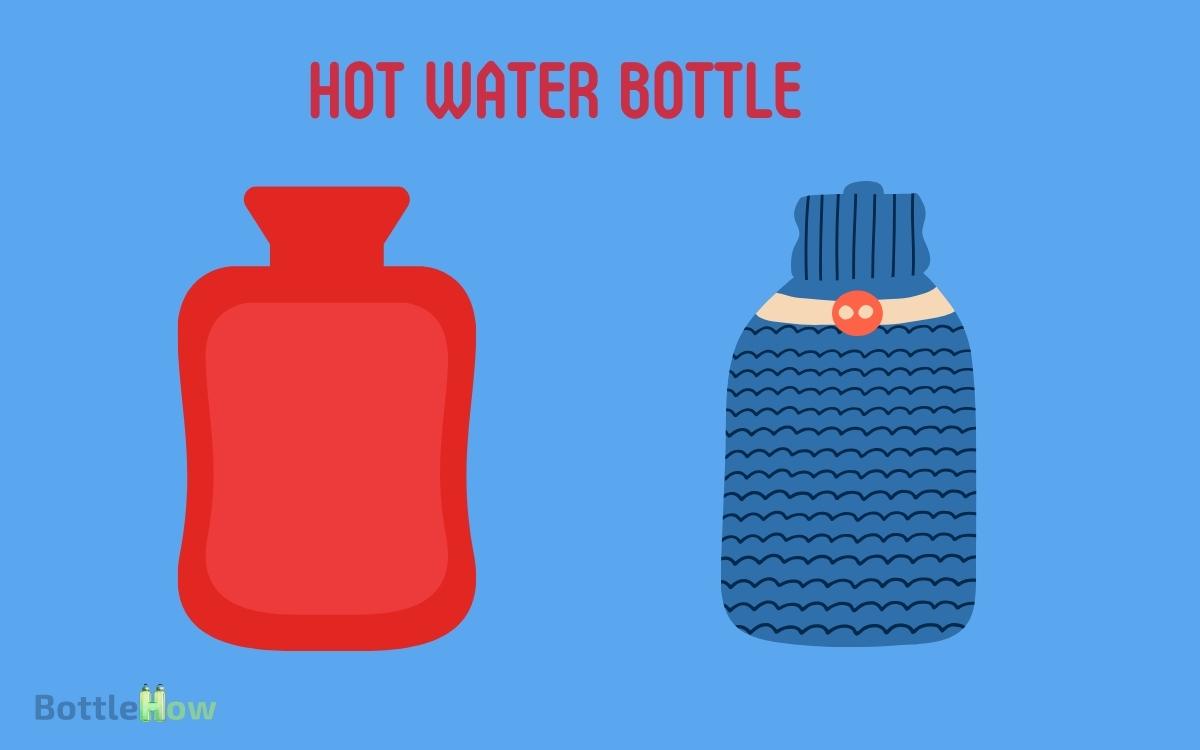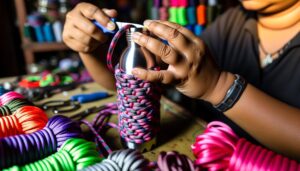Hot Water Bottle American Name: Find Out Here!
In the United States, you’ll typically hear the term ‘hot water bottle‘ for a container filled with hot water used for warmth and comfort.
Some people also call it a ‘rubber hot water bottle.’ Historically, they’ve evolved from metal designs to safer, more comfortable rubber or plastic versions.
Depending on where you’re located, you might hear different names like ‘bed warmer‘ in the Northeast or ‘comfort bottle‘ in the South.
These terms reflect regional dialects and historical usage. Each name points to the same essential purpose—providing warmth and relief. There’s more to uncover about its versatility and benefits.

Key Takeaways
Common American Terms
In American English, a hot water bottle is commonly referred to simply as a ‘hot water bottle’ or occasionally a ‘rubber hot water bottle.’ You’ll find that these terms are used interchangeably to describe the same item.
A hot water bottle is a container typically made of rubber or thermoplastic, designed to hold hot water. It’s used to provide warmth, relieve pain, or offer comfort.
When discussing hot water bottles, Americans rarely use alternative names or jargon. Instead, they stick to these straightforward terms.
Understanding these common terms can help you communicate more effectively about this household item, whether you’re shopping for one, discussing its uses, or simply talking about ways to stay warm.
Historical Background
You might find it interesting that hot water bottles were used in America as early as the 19th century to provide warmth and comfort.
Over time, their design has evolved from simple metal and ceramic containers to the more convenient rubber and plastic versions we see today.
This evolution reflects advancements in materials and a growing focus on safety and usability.
Early Uses in America
Hot water bottles, initially known as ‘bed warmers,’ found their way into American households during the early 19th century.
You’d often see them used to combat cold winter nights before central heating became common. People would fill them with hot water before bedtime to keep their beds warm and comfortable.
These early bed warmers were primarily made of metal, such as copper or brass, and sometimes even earthenware.
You’d place them under the covers a few minutes before getting into bed. This practical use made them an essential item, especially in rural areas where heating systems were less advanced.
Their simplicity and effectiveness made sure that they became a household staple for many American families during that period.
Evolution of Design
Starting as simple metal containers, hot water bottles have undergone significant design changes over the years to improve usability and safety. Initially, metal hot water bottles were prone to leaks and burns, posing hazards.
Over time, manufacturers introduced rubber materials, which were more flexible and less likely to cause injuries.
Modern designs now include features like insulated covers and advanced sealing mechanisms to prevent spills.
Consider the impact of these changes:
- Enhanced Comfort: Soft, flexible materials reduce the risk of burns.
- Improved Safety: Better seals and materials minimize leak risks.
- Increased Convenience: Modern designs are easier to fill and use.
- Extended Durability: High-quality materials last longer, providing better value.
Regional Variations
Across different regions of the United States, the term for a hot water bottle can vary greatly. In some areas, you might hear it referred to as a ‘warming bottle‘ or simply a ‘heat bottle.’ The variations largely depend on local dialects and historical influences.
For instance, in the Northeastern states, it’s often called a ‘bed warmer,’ reflecting its traditional use in cold climates.
In Southern regions, you may encounter the term ‘comfort bottle,’ highlighting its soothing purpose.
These regional differences can sometimes cause confusion, but they all refer to the same basic item.
Understanding these variations helps you communicate more effectively and recognize the cultural nuances that shape everyday language across the country.
Popular Brands
When selecting a hot water bottle, you’ll find several popular brands that stand out for their quality and reliability.
These brands have earned their reputation by consistently delivering products that are safe, durable, and effective.
Here are some top choices that might evoke a sense of comfort and trust:
- Fashy: Renowned for their innovative designs and high-quality materials.
- Hugo Frosch: Known for eco-friendly and sustainable options.
- Kirkland Signature: Offers affordable yet reliable hot water bottles.
- HomeTop: Popular for their stylish and functional designs.
Choosing one of these brands offers you a product that meets high standards. Whether you’re looking for comfort, durability, or eco-friendliness, these brands have got you covered.
Cultural Significance
In addition to their practicality and brand reliability, hot water bottles hold significant cultural value in various parts of the world. In the UK, they’re a winter staple, often used for warmth during cold nights.
In Japan, the ‘yutanpo’ is a traditional companion for cozying up during chilly seasons. In many cultures, they’re not just heating devices but symbols of comfort and care, often given as thoughtful gifts.
They also play a role in rituals and traditions, such as using them to warm beds before sleep in some European countries.
Understanding these cultural contexts reveals how hot water bottles transcend their basic utility, becoming cherished household items imbued with emotional and cultural significance.
Health Benefits
You’ll find that a hot water bottle can greatly aid in pain relief by soothing muscle aches and joint pains.
It also helps improve blood circulation, promoting better overall health.
Additionally, using a hot water bottle can reduce muscle tension, making it a simple yet effective remedy for stress-related discomfort.
Pain Relief Aid
A hot water bottle offers an effective and natural method for alleviating various types of pain and discomfort. When you use one, you can experience immediate relief from ailments without relying on medication.
The heat from the bottle helps to relax muscles, reduce stiffness, and soothe aches, making it a versatile tool for pain management.
Consider using a hot water bottle to address:
- Menstrual cramps: Eases abdominal pain and tension.
- Muscle soreness: Relieves post-exercise discomfort.
- Joint pain: Soothes arthritis and chronic conditions.
- Back pain: Provides warmth and relaxation for strained muscles.
Improves Blood Circulation
Besides pain relief, a hot water bottle can also improve blood circulation, offering additional health benefits.
When you apply heat to your body, it causes your blood vessels to dilate, increasing blood flow to the affected area.
This enhanced circulation helps deliver more oxygen and nutrients to tissues, promoting faster healing and reducing inflammation.
Improved blood flow can also alleviate discomfort from conditions like arthritis and menstrual cramps.
By using a hot water bottle, you’re not just targeting pain, but also supporting your body’s natural healing processes.
Remember to wrap the bottle in a cloth to prevent burns and avoid prolonged use to guarantee safety. Additionally, always check the temperature of the bottle before placing it against your skin to minimize the risk of discomfort or injury. Following safety guidelines is essential, just as adhering to the water bottle policy at Cinemark ensures a smooth experience for all guests. By taking these precautions, you can use the bottle effectively while prioritizing your well-being.
Using a hot water bottle wisely can be a simple yet effective way to boost your circulation.
Reduces Muscle Tension
Frequently, using a hot water bottle can help reduce muscle tension, making it a reliable tool for soothing sore muscles.
The warmth from the bottle increases blood flow to the affected area, relaxing tight muscles and easing discomfort.
Consider the following benefits:
- Immediate Relief: Feel a soothing sensation almost instantly.
- Natural Solution: Avoid medications and use a simple, effective method.
- Portable Comfort: Take it anywhere and use it anytime.
- Affordable Care: A cost-effective way to manage muscle pain.
Modern Alternatives
Today, you can choose from several modern alternatives to the traditional hot water bottle, offering enhanced convenience and safety.
Electric heating pads are a popular option, allowing you to adjust the temperature to your preference. They provide consistent heat without the need to refill or worry about water spills.
Microwaveable heat packs are another great choice, filled with materials like rice or gel. Simply microwave them for a few minutes for long-lasting warmth.
Gel packs, often reusable, can be heated in hot water or microwaves and offer flexibility in use.
Lastly, there are battery-operated heating pads, which are portable and ideal for on-the-go relief. These options make sure you can enjoy warmth and comfort with minimal hassle.
Usage Tips
To maximize the benefits of your hot water bottle, always check for leaks before use and make sure the water temperature is safe to avoid burns.
Fill the bottle with water that’s hot but not boiling. Overheating can cause damage and increase the risk of burns. When sealing the bottle, ensure the cap is tightly secured to prevent any leaks.
Here are a few tips to enhance your experience:
- Verify the water temperature: Avoid burns by testing the water on your wrist first.
- Use a cover: A soft cover adds comfort and insulation.
- Monitor usage time: Limit to 20 minutes to avoid overheating your skin.
- Store properly: Keep it empty and dry when not in use to prevent mold.
Following these tips will guarantee safe and effective use.
Conclusion
So, there you have it! While ‘hot water bottle‘ remains the common term in America, understanding its historical context, regional variations, and modern alternatives can enrich your appreciation.
Brands and cultural significance highlight its enduring charm, while health benefits make it a practical choice. Just like an old-timey phonograph, it retains its usefulness in a modern world.
Remember these tips, and you’ll make the most out of this timeless comfort.






